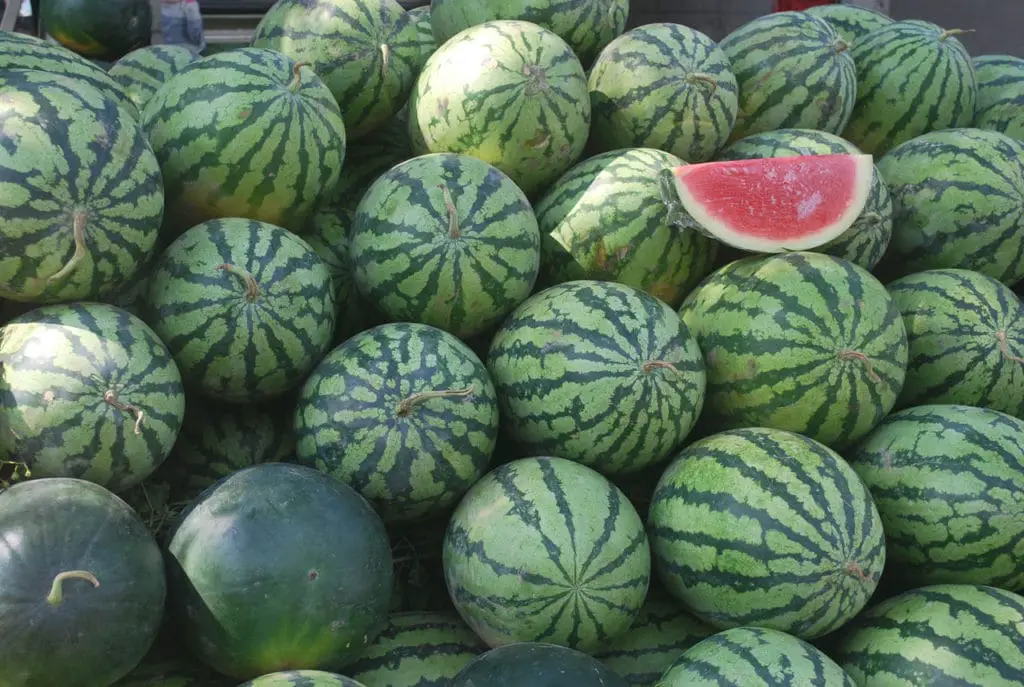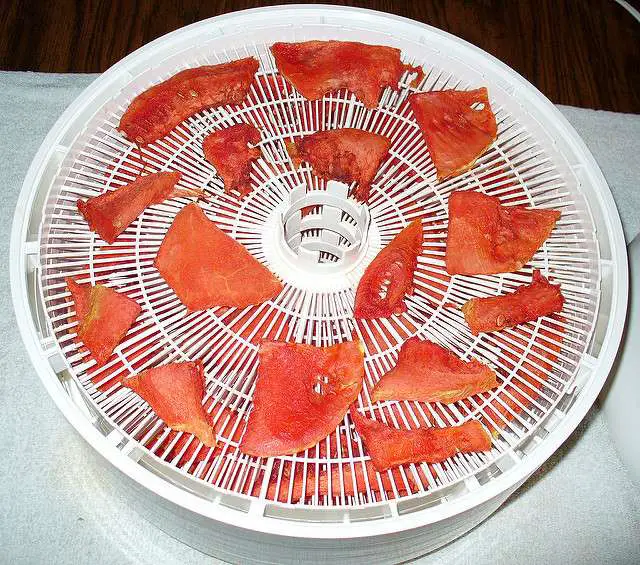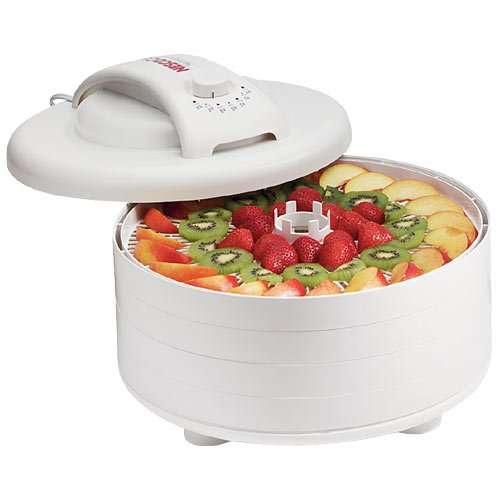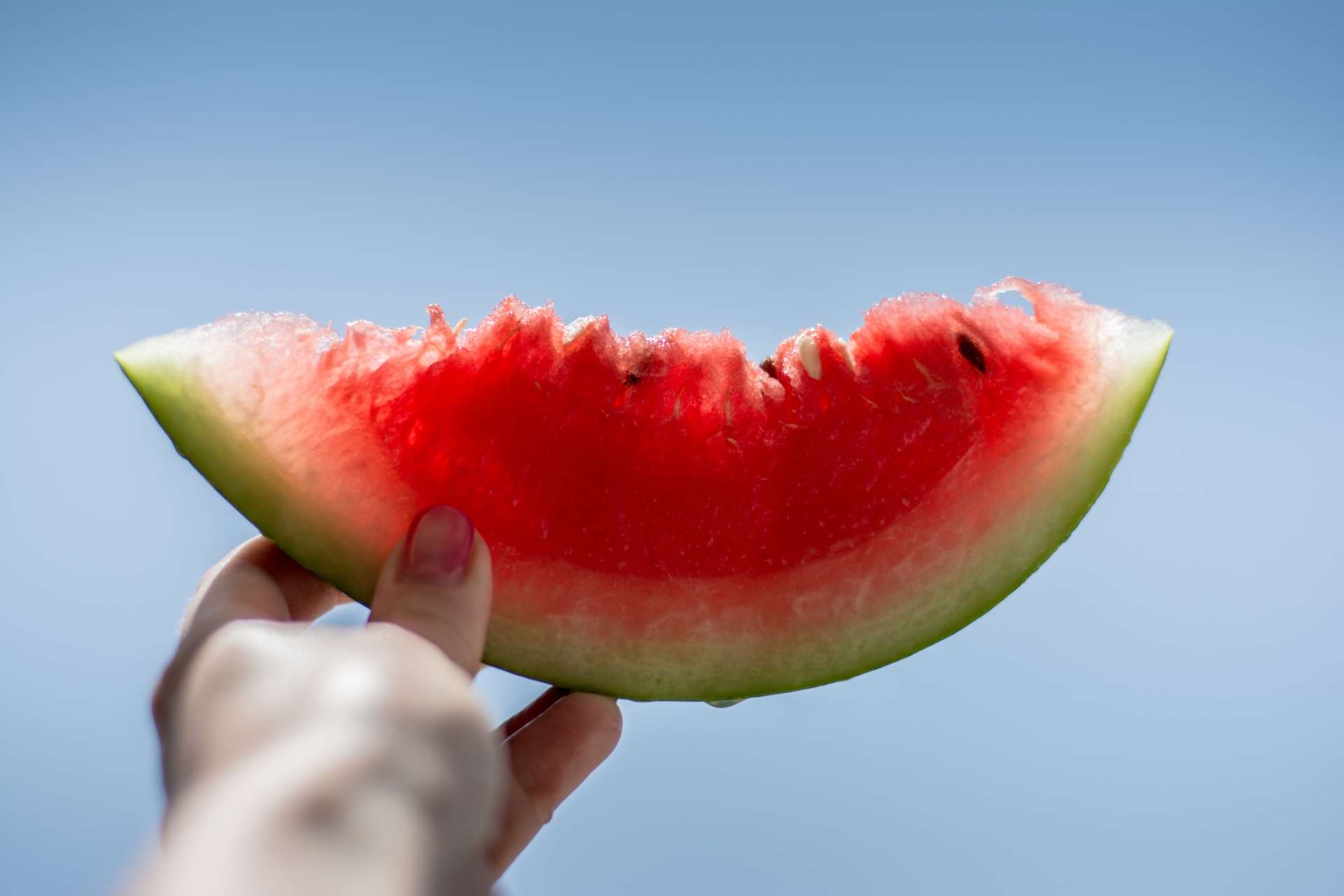Watermelon (Citrullus lanatus) is a large edible fruit grown mostly in the tropics. It is a special kind of berry because it has many seeds. It has a hard, green to dark green rind (some with dark green stripes) and no divisions inside. Its juicy, watery flesh is usually deep red embedded with small black seeds, although there are now seedless varieties available. Did you know that dehydrated watermelon actually exists? Some compare it to healthy candy. Let’s look at all the details.
Watermelon is juicy and sweet. It is a popular fruit during summer. It is usually eaten fresh in slices, or diced in salads, or blended as juice. Its seeds, when dried or roasted, have a nutty flavor. The rind is also edible when cooked or pickled.
Table of Contents
History
Watermelon originated in northeast Africa as a wild flowering plant. Then it spread to the other parts of Africa and India. Cultivation of watermelons in the Nile around the second Millenium was one of the earliest records found in history. By the 7th century, India had been cultivating watermelons and China followed suit by the 10th century.
Ancient trade relations among countries and colonial occupations across continents had brought the watermelon worldwide. Today, many varieties have been developed including the seedless and the cubed watermelons.
The Plant
Watermelon is an annual plant, meaning you can only plant and harvest watermelons once a year. It is a vine that crawls across the land. Its stems measure 3 meters long and the new growing stems have yellow or brown hairs on it. Its leaves measure 6 to 20 cm long, 4 to 15 cm wide. They thrive in tropical and subtropical temperatures higher than 25°C.
Varieties
There are many varieties of watermelon, both seeded and seedless kinds. Here are some of the few we’ve seen:
- Bengal Tiger – This variety is round, with light green rind and dark green stripes. The flesh is red and sweet. The fruit weighs 7 to 9 kg.
- Sugar Baby – This is the most popular variety all over the world. It is round, with dark green rind and no visible stripes. Its flesh is red and sweet. The fruit weighs 4 to 6 kg.
- Zebra Golden – This variety is oval-shaped, with light green rind and dark green stripes. The flesh is yellow and sweet. A single fruit weighs 4 to 5 kg.
- Diana – This variety is also oval-shaped, with golden yellow rind. Its flesh is bright red which is soft and juicy. The fruit weighs 2 to 4 kg.
- Tiffany – This variety is also oval-shaped, dark green rind with no visible stripes. Its flesh is yellow, which is crisp and juicy. The fruit weighs 2 to 4 kg.

Is it a Fruit or a Vegetable?
Just like the tomatoes, people have debated whether watermelon is a fruit or a vegetable.
Watermelon is considered a fruit because botanically speaking, it is a fruit of a vine. Considered as a melon, thus the name but it is not included in the genus Cucumis. It has a smooth rind on the outside and a juicy, sweet flesh inside. Most of us use watermelon as a fruit, eaten fresh, included in desserts or salads, or juiced to make a drink.
However, watermelon can be considered as a vegetable because it is a member of the Cucurbitaceae family where most gourds are classified. So it is related to the cucumber, squash, pumpkin. Unbelievable, but true. Watermelons are planted from seeds, harvested, and cleared from the field just like any other farmed vegetable. In China, watermelon rind could be cooked and eaten or pickled like any vegetable.
Scientifically speaking, the scientific name of watermelon is Citrullus lanatus, a member of the Cucurbitaceae family. If you would look at its classification, it belongs to the Kingdom Plantae, Class Angiosperms (flowering plants), Class Eudicots, Class Rosids, Order Cucurbitales (pumpkins and melons), Family Cucurbitaceae, Genus Citrullus, Species C. lanatus
So, is it a fruit or a vegetable? It is just a matter of perspective. If you remember the debate on the tomato, although it is scientifically classified as a fruit, most people use it as a vegetable. Therefore, in the case of watermelons, it may be classified as a vegetable, but we use it widely as a fruit.
RELATED ARTICLE: To-ma-to or To-mah-to? It’s Still Dried Tomatoes to Me
Dehydrated Watermelon Guide

Watermelon candy is a fancy name for dehydrated watermelon. It is sweet, a little bit chewy. It tastes similar to the watermelon-flavored Jolly Rancher candies but much better (and healthier).
To make great tasting dehydrated watermelon, choose a firm watermelon without cuts or bruises, cracks or dents. It should be heavy for its size. As its name suggests, watermelon contains 91% water. Turn it over and it should have a creamy yellow spot from where it sat on the ground and ripened in the sun. Elderly people try to tap or knock their fingers on the watermelon and listen to its sound. If it sounds dull, firm and robust from the inside, they would say that it’s juicy.
Preparation For Drying
- Wash the melon under a cool tap running water.
- Dry it with a clean cloth or paper towel.
- Slice the watermelon crosswise into 1/2″-thick slices.
- Cut the slices in half.
- Remove the flesh from the rind by cutting along the white flesh.
- Remove the seeds.
- Cut the watermelon pieces into wedges or strips.
- After cutting, dry it immediately.
As much as possible, make the slices no thicker than 1/2″. The thicker the pieces, the more it gets spongy and gummy after drying. That would not be a good texture when dried.
Drying Using a Food Dehydrator
The dehydrator is an often overlooked home kitchen appliance because only a few realize that it can save money and freezer space. Why would you want to dry watermelon? Well, maybe you just want to taste what a home-made dehydrated watermelon tastes like. The dehydrator is the preferred drying method for watermelon because the temperature can be easily controlled so there’s no worry of over-drying.
If you’re contemplating purchasing a food dehydrator, check out some of the best food dehydrators in the market.
RELATED ARTICLE: NESCO® FD-60 Snackmaster Food Dehydrator

- Arrange the slices on the dehydrator trays over the sink. This allows the pieces to drain since these are watery. Make sure the slices on the trays are in a single layer with no overlap.
- Set the thermostat at 135°F. Dry for 3 to 4 hours; then after that, rotate the trays if necessary.
- Rotate the trays every 3 to 4 hours until they’re evenly dried, crisp, and no longer sticky or gummy.
Drying watermelon in the dehydrator generally takes 18 to 20 hours. Of course, drying times may vary depending on the water volume in your watermelon, the heating power of your dehydrator, and the humidity in the air.
When done properly, dehydrated watermelon pieces would look like fruit leather. Take the trays out and lift off the pieces, but let them settle on the tray. If you see dark cross hatches in your tray, that means the sugars from the watermelon have stuck. Don’t worry, you can still remove them by washing the trays in warm soapy water.
Drying Using an Oven
Drying watermelon in the oven usually requires 18 hours or more. The oven-drying method works best for small batches. Follow these steps:
- Arrange the watermelon slices in a single layer on a baking tray or cookie sheet without overlapping the pieces. Allow 1 1/2 inches of space on each side of the tray for air circulation.
- Turn the oven on the lowest temperature or at 140°F before placing them in the oven. Make sure the oven thermometer is visible for you to monitor every 30 minutes. It is important to maintain the heat within 140° to 160°F. To do this, you may need to prop the oven door slightly ajar or place a small fan in front to allow air circulation.
- Flip the watermelon slices every 30 minutes to prevent sticking. The watermelon is dry when it is no longer moist and sticky.
- Let the dehydrated watermelon slices cool at room temperature before storing in airtight containers.
Depending on the type of oven you own, it is either electric or propane powered. The problem with using ovens is that they require much more power. This means that by having your oven on for 18 hours, you’ll be consuming lots of electricity or propane.
Sun Drying
Dehydrating watermelons under the sun could be difficult and could provide varied results because of its sugar and water content. The sun is also less dependable than dehydrators or ovens especially if the humidity is low.
- Arrange the watermelon pieces on a tray.
- Cover the tray with a net or cheesecloth to protect the fruit from insects.
- Place the tray under direct sunlight and turn the fruit slices daily.
- If the temperature drops at night or if it rains, bring the tray inside to prevent moisture from returning.
Using the sun to make dehydrated watermelon may take two to four days assuming you live in an area where the sun is strong and the weather doesn’t vary too much.
Nutritional Value
Fresh watermelon fruit is 91% water, contains 6% sugars, and is low in fat. A 100-gram serving provides 30 calories and low amounts of essential nutrients. Only 10% of the Daily Value of vitamin C is present in watermelons but its pulp contains carotenoids, including lycopene.
Final Thoughts
Whether it’s a fruit or a vegetable, it doesn’t matter. Watermelons have become an icon for summer and the tropics. Dehydrated watermelon is sweet like candy which makes for a healthier alternative to sweet treats that are heavily processed with artificial ingredients.
A food dehydrator will yield the best results because of the controlled temperature the machine offers. It will allow you and your loved ones to enjoy consistently good dehydrated watermelon all year round.
If you found this article to be helpful, be sure to check out more of our helpful tips! Thanks for reading!

